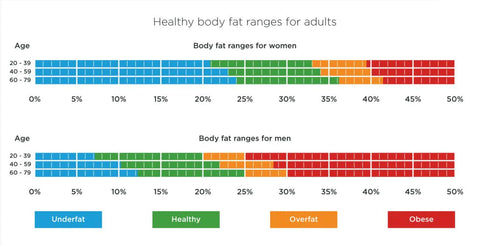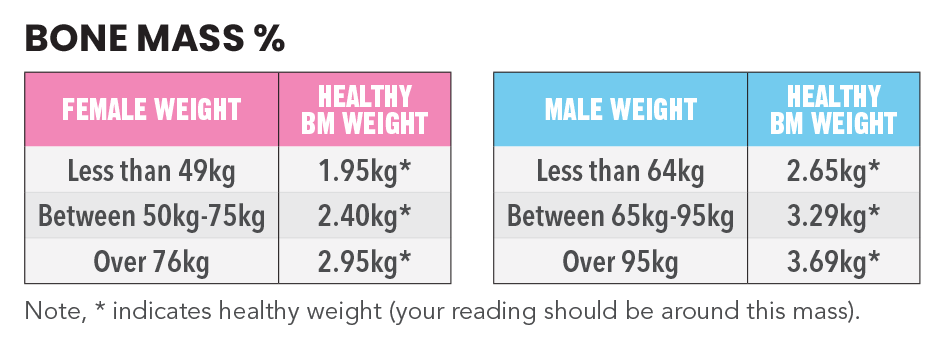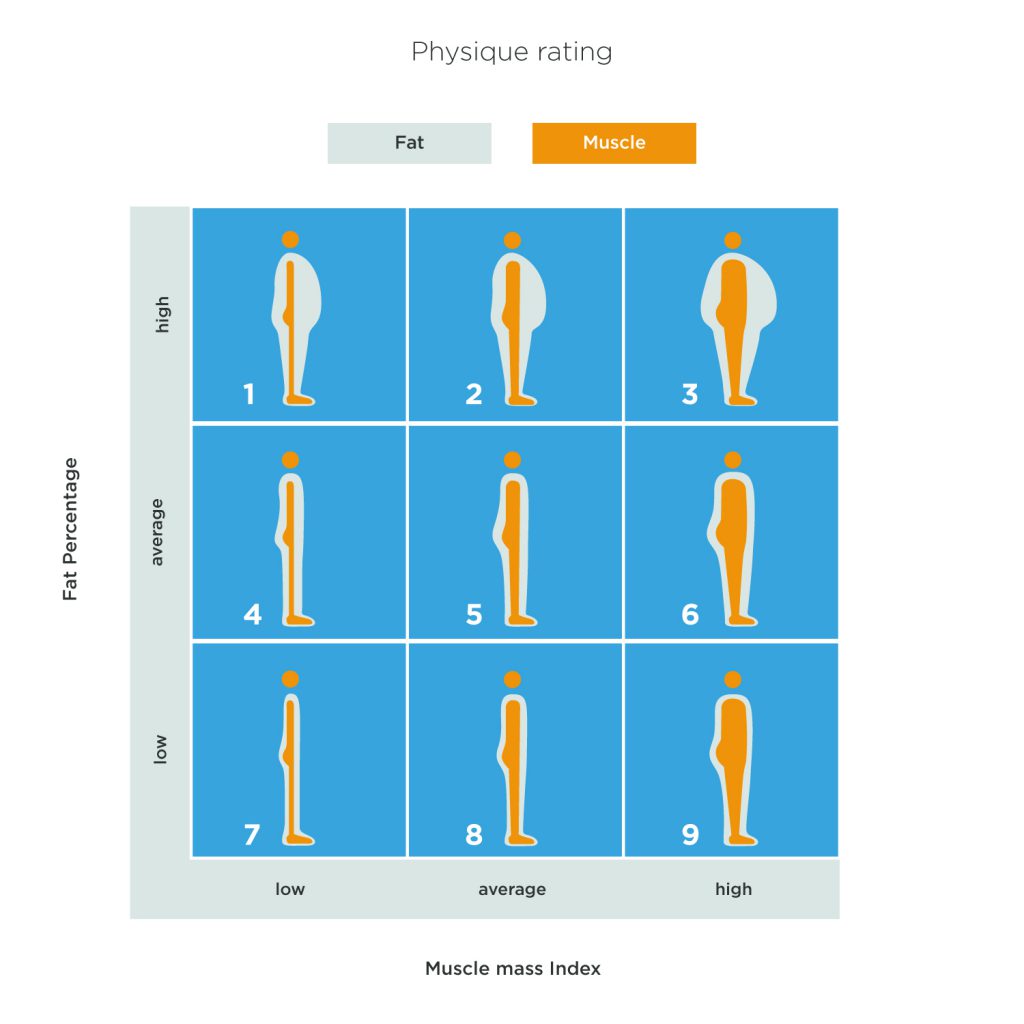
Understanding Your Measurements
If you can measure it, you can manage it!
Time to find out what you’re made of.
Understanding Body Composition with TANITA
Body composition refers to the percentages of fat, muscle, bone, and water in the human body. Unlike basic weight scales, TANITA Body Composition Monitors provide a detailed insight into these key health indicators, giving you a clearer picture of your inner health.
With over 70 years of experience and more than 30 years developing advanced BIA technology, TANITA has led the way in accurate body composition analysis. Using our cutting-edge dual-frequency Bioelectrical Impedance Analysis (BIA), our monitors deliver fast, precise results trusted by health professionals worldwide, from personal trainers and dietitians to general practitioners and medical specialists.
This page outlines the different body composition measurements available and explains how they affect your health and wellbeing. Click the links to explore each measurement in detail.
Whether you're managing weight, improving fitness, or supporting clinical care, TANITA’s body composition monitors help track your progress and support better long-term health outcomes.
Collapsible content
Body Fat Percentage and Body Fat Mass
Body Fat Percentage is the proportion of fat to the total body weight. Body Fat Mass is the actual weight of fat in your body.
Body fat is essential for maintaining body temperature, cushioning joints and protecting internal organs. Body fat scales can help you keep track of your body fat.
The energy, or calories, our body needs comes from what we eat and drink. Energy is burned through physical activity and general bodily functions. If you consume the same number of calories as you burn, all the calories are converted into energy. But if you consume more than you burn, excess calories are stored in fat cells. If this stored fat is not converted into energy later, it creates excess body fat.
Although you need healthy body fat, too much fat can damage your long-term health. Reducing excess levels of body fat has been shown to directly reduce the risk of certain conditions such as high blood pressure, heart disease, type 2 diabetes and certain cancers.
Too little body fat may lead to osteoporosis in later years, irregular periods in women and possible infertility.
It is important to keep track of your body fat with a body fat scale. Then you can check your body fat results against the Tanita healthy body fat ranges. These measurements are available for everyone from age five to 99 years.
For children’s health body fat ranges click image:

For adult’s healthy body fat ranges click image:

Total Body Water
What is Body Water and why is it Important?
What is body water?
What is the ideal body water percentage?

How can I increase my total body water percentage?
It’s important not to wait until you feel thirsty to hydrate, as thirst can often be a late indicator of dehydration, particularly in colder environments or when you’re busy or stressed. Making hydration a daily habit can help; carry a water bottle with you and incorporate regular water intake into your routine.
Starting your day with a glass of water is a great practice, as it helps to flush out toxins and waste from your body. Another effective way to boost your body water percentage is by including raw fruits and vegetables in your diet, as they are high in water content. This can complement your fluid intake and provide hydration in a tasty, nutritious way.
Lastly, aim to drink enough fluids so that your urine is light in colour and you are urinating frequently. This can be a good indicator that you’re properly hydrated. By integrating these habits into your daily routine, you’ll enhance your body water percentage and maintain optimal hydration.
How will I know when I have increased my total body water percentage?
In addition to using a body composition monitor, there are several other indicators you can observe to gauge your hydration status:
- Urine Colour: A key sign of good hydration is light, pale yellow urine. Darker urine may indicate dehydration and the need for more fluids.
- Frequency of Urination: Increased hydration generally results in more frequent urination. If you notice that you’re visiting the bathroom more often, it may be a sign that you’re well-hydrated.
- Physical Symptoms: Improved hydration often leads to noticeable benefits such as enhanced skin texture, increased energy levels, and better digestive function. Well-hydrated skin is typically more elastic and less dry, while proper hydration can reduce feelings of fatigue and support regular bowel movements.
- Overall Well-being: Proper hydration can also impact your overall health and well-being. You may experience reduced cravings, which are sometimes mistaken for hunger, and better physical performance during exercise.
Visceral Fat Rating
What is Visceral Fat and why is it important?
How to measure Visceral Fat?
How to reduce your Visceral Fat Rating?
- Reducing the intake of sugar and refined carbohydrates.
- Filling up on non-starchy vegetables, fats and proteins.
- Exercising regularly.
- Getting more potassium in your diet.
- Reducing stress.
- Focusing on getting enough sleep.
Muscle Mass

What is Muscle Mass?
To manage your muscle mass and body fat percentage, it’s important to first understand what these body composition measurements actually mean.
Many people assume that building muscle automatically reduces fat, but while the two can be related, they’re not the same thing.
Muscle mass refers to the total weight of all muscles in your body, including skeletal muscles, smooth muscles like the heart and digestive system, and the water stored in those muscles. These muscles play a crucial role in energy consumption, they act like engines, burning energy even at rest.
On the other hand, body fat percentage measures the proportion of fat in your body. Increasing muscle mass boosts your metabolism, which can lead to fat loss and improved fitness. This also increases your Basal Metabolic Rate (BMR) which is the number of calories your body burns at rest. That’s why tracking muscle mass can be just as important as monitoring fat levels.
Muscle mass includes skeletal and smooth muscle, plus the water stored within. Since muscle tissue is made up of water and protein, it’s essential to include adequate protein in your diet to support muscle development.
How to Gain Muscle Mass
There are some differences in how men and women gain muscle. Men typically have higher testosterone levels, which supports faster muscle growth, but that doesn’t mean women can’t gain strength and size.
Women can achieve significant gains in both power and muscle mass. The training principles are the same for both sexes: consistency, strength training, proper nutrition, and rest.
Building muscle mass doesn’t happen just in the gym, it happens in the kitchen too. Eating the right foods for muscle growth is just as important as training. To build muscle, you need to consume more calories than your body burns, but the quality of those calories also matters.
Start by calculating your Basal Metabolic Rate (BMR). Your BMR tells you how many calories you burn at rest. Aim to eat slightly above that to promote growth. It's important to monitor your results as you increase your intake. If your fat levels rise, reduce your intake. If you’re not gaining muscle, increase it.
While you're making improvements to your diet, health and fitness routines, use a Tanita Body Composition Monitor to track both muscle and fat levels accurately.
When it comes to food:
- Prioritise protein: chicken, turkey, yoghurt, beans, nuts and fish are all great sources.
- Don’t forget complex carbohydrates and healthy fats, your body needs these too.
- Eat a balanced, high-protein diet and avoid excessive junk food.
Other important tips for muscle growth:
- 💧 Stay hydrated by drinking plenty of water
- 🏋️ Follow a structured strength training program
- 🛌 Get 7–9 hours of sleep per night
- ❌ Limit alcohol intake
- 🧘♂️ Reduce stress through mindfulness or relaxation techniques
Everyone builds muscle at a different rate, depending on genetics, age, training experience, and muscle memory. We recommend you speak to your health professional for advice that is best suited to your needs and health journey.
Muscle Balance
As you grow stronger, be mindful of muscle balance. Imbalances happen when certain muscles grow faster than others, like training your chest but not your back. This can lead to poor posture, joint strain, and injury.
Make sure you train opposing muscle groups evenly. A balanced workout routine supports better posture, performance and injury prevention.
How to Measure Muscle Mass
More contractile tissue = better muscle quality.
To improve this, aim to strengthen your muscles and reduce non-contractile tissue (like fat). Strength training exercises help with both.
Even if you're a runner or cardio lover, consider adding resistance training to your routine for optimal results.
Measuring & Tracking Muscle Mass with Tanita
Tanita’s advanced Body Composition Monitors use professional-grade dual-frequency BIA technology to accurately measure your muscle mass. Our segmental Body Composition Monitors track both total and segmental muscle mass, meaning you can see how muscle is distributed across your body.
Traditional bathroom scales won’t show this. You may gain muscle and lose fat, but the number on the scale stays the same. With a Tanita scale, you’ll see the true body composition changes happening beneath the surface.
By tracking your results over time, you can:
- Set realistic health and fitness goals
- Stay motivated with accurate muscle and fat readings
- Identify and correct muscle imbalances
- Track your muscle growth progress
That’s why Tanita is trusted by fitness professionals and health experts worldwide.
Basal Metabolic Rate
What is Basal Metabolic Rate?
A deeper understanding of Basal Metabolic Rate
Metabolic Age
How to calculate you Basal Metabolic Rate?
There are two calculations you can use to manually calculate you (BMR)
Do you want to gain muscle mass or lose it?
Bone Mass
Why is healthy bone mass important?
Nutrients that contribute to good bone mass
- Calcium
- Vitamin D
- Vitamin K
- Potassium
- Magnesium
Things to reduce or avoid
- Alcohol
- Caffeine
- Smoking
How do I find out my bone mass?
Muscle Quality
Are you as strong as you look?
Why does muscle quality differ?
Differences within one person
Improving your muscle quality
Physique Rating
Find out what body type you have
Measuring accurately
Different body types
Physique Rating 1: Hidden Obese
Physique Rating 2: Obese
Physique Rating 3: Solidly-built
Physique Rating 4: Under exercised
Physique Rating 5: Standard
Physique Rating 6: Standard Muscular
Physique Rating 7: Thin
Physique Rating 8: Thin and Muscular
Physique Rating 9: Very Muscular
How to keep track of your physique rating?
Body Mass Index
BMI - Body Mass Index: a very rough indication
Why BMI was developed?
Why BMI is inaccurate?
Measuring accurately
Athlete Mode
When you set up a user profile on most Tanita Body Composition Monitors and Tanita Body Fat & Hydration Monitors, you may notice that it asks you if you are an athlete. There is a very important reason for this, and it is important to select the correct setting based of your lifestyle.
Why is there a separate Athlete mode feature on Tanita Body Composition Monitors?
Athletic body types are physiologically different than standard adult body types, due to muscle mass and hydration level differences. Athletes tend to have greater muscle mass and tend to be more dehydrated. These differences would skew the body fat reading high, when taken with the standard Adult mode.
When Athlete Mode is recommended?
You should chose 'athlete mode' if you're over the age of 18 and if:
-
you train or exercise for 10-12 hours or more a week and have been doing so for at least 6 months.
- you are a body builder, weightlifter, power lifter or strongman/strongwoman.
- you are professional athlete who wants to monitor their progress at home.
- you belong to a sports team or a sports organisation with the aim of participation in competition, etc.
- you have a lifetime history of fitness and you are someone who used to do more than 12 hours a week of training or exercise but do less now.
- you have a resting heartbeat of under 60bpm (Keep in mind, some people naturally have a low heart rate – only chose athlete mode if you are actively training at moderate or intense level.)
Segmental Analysis
To explain segmental analysis, it’s important to understand body composition.
What Is Body Composition?
With respect to health and fitness, body composition is used to describe the percentages of fat, bone and muscle in the human body.
Two people at the same height and same body weight may have different health issues because they have a different body composition.
What is a Body Composition Monitor?
A body composition monitor sends an imperceptible current through your body. This technology is called bioelectrical impedance analysis (BIA). Muscle, fat, bone and water conduct electricity at different rates. These rates of resistance are measured by the monitor.
The body composition monitor processes this information combined with formulas and data such as your gender and age. This provides you with a wealth of measurements regarding fat, muscle, bone and water to give you a reading for:
- Body Fat %
- Total Body Water
- Muscle Mass
- Muscle Quality
- BMR
- Metabolic Age
- Visceral Fat Rating
- Physique Rating
- Bone Mass
- BMI
Body composition monitors offer you a much more complex analysis of your body’s total make up, especially compared to something more rudimentary than a set of bathroom scales that only offers up your total body weight (check out our blog article on weight vs body composition).
What Is Segmental Analysis?
Segmental analysis allows you to take your understanding of your body composition measurements to an even deeper level.
Segmental analysis divides the body into 5 key areas to provide additional measurements of muscle mass and body fat % for each body segment:
- Torso (or trunk)
- Left arm
- Right arm
- Left leg
- Right leg
Segmental Analysis of Muscle Mass
Segmental Analysis of Body Fat Percentage
Why is Segmental Analysis beneficial?
So why is it important to get a reading for parts of your body rather than your body as a whole?
Segmental analysis allows you to identify which area of your body requires the most attention and with that information can help you tailor your health and fitness routines to create better body balance & symmetry. For example, you may find that your overall muscle mass could be improved by adding more muscle to your legs, or you might find that your body fat levels are higher in your torso, meaning it’s time to make some changes on the plate or change up your exercise routine.
How do you complete Segmental Analysis?
So how is this measured? Tanita’s segmental body composition monitors conduct a segmental analysis every time you step on and are designed to accurately measure and present you with all of your stats and info. With more electrodes than a standard body composition monitor, they’re able to offer measurements with even higher accuracy for each of the 5 body areas.
Who Is Segmental Analysis For?
At this point you might be wondering “do I need to know my segmental analysis?”
The truth is that information at this level is not needed for most people, and a standard body composition monitor will give you all the stats you need and more for you to gain a true insight into your total body health.
However, if you’re someone who is interested in fine-tuning your training or maximising your results as much as possible (such as an athlete or bodybuilder), then segmental analysis is going to allow you to dig deep into your stats and give you as much information as possible to guide your fitness goals.
Similarly, with the rise of smartwatches and wearable fitness trackers, we’ve seen how useful technology is for our health and fitness, and how much we come to rely on this readily available information. Those who are interested in fitness technology and tracking their results in a central data hub will also get a lot of use out of a bluetooth segmental body composition monitor.
Even if you’re not someone who really needs to rely on segmental analysis, Tanita offers a range of products to help guide you on your health and fitness journey, no matter what that looks like.
For more information, tips and tricks, check out the Tanita lifestyle blog.



